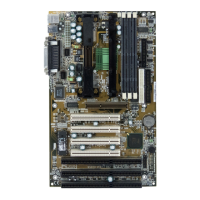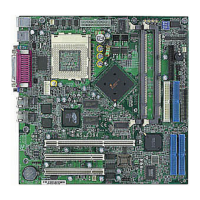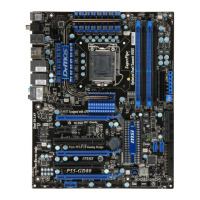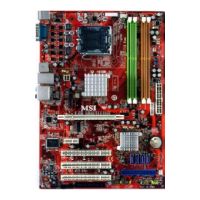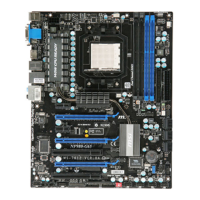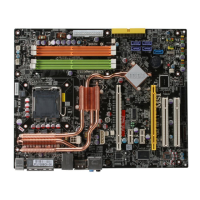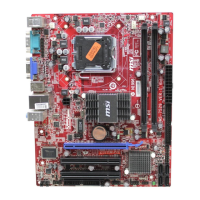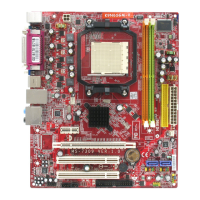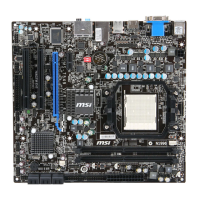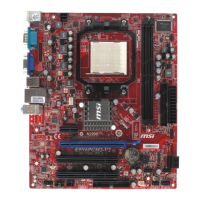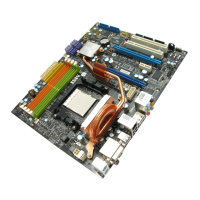Do you have a question about the MSI MS-6378 ATX and is the answer not in the manual?
Lists the technical specifications of the MS-6378 mainboard, including CPU, chipset, memory, and slots.
Diagram showing the physical layout of connectors and components on the MS-6378 mainboard.
A table mapping components to their functions and corresponding page references.
Highlights the primary functionalities and technological aspects of the MS-6378 mainboard.
Details proprietary MSI features like PC Alert III and other special capabilities.
Guide for installing the CPU and managing thermal requirements for optimal processor operation.
Information on SDRAM types, DIMM sockets, and valid memory module combinations.
Details on connecting the ATX 20-pin power supply connector to the mainboard.
Description of external ports on the back panel, including USB, PS/2, VGA, COM, and audio.
Configuration and connection details for IDE1 (Primary) and IDE2 (Secondary) hard disk drives.
Explanation of jumper settings for CMOS clearing, audio codec, and USB keyboard wake-up.
Information on PCI, CNR, and optional ISA slots for adding expansion cards.
Instructions on how to enter the BIOS setup and use control keys for navigation.
Overview of the BIOS main menu structure and accessing context-sensitive help.
Settings for date, time, IDE devices, and floppy drive configurations.
Configuration options for boot order, virus protection, cache, and system security.
Options to optimize chipset performance, DRAM timings, and AGP settings.
Settings for onboard IDE, serial, parallel, USB, audio, and LAN controllers.
Configuration of system power saving modes, ACPI features, and wake-up events.
Managing Plug and Play and PCI device resource assignments like IRQ and DMA.
View current system hardware status, including temperatures, voltages, and fan speeds.
Adjust CPU host bus and PCI clock frequencies, and related voltage settings.
Restoring BIOS to Fail-Safe or Optimized default values for stability or performance.
Configuring Supervisor and User passwords for BIOS access and system boot protection.
Procedures for saving configuration changes or exiting without saving.
Basic system requirements for installing VIA and Realtek drivers on DOS, Windows, and OS/2.
Step-by-step instructions for installing VIA chipset drivers on Windows 98SE, 2000, ME, and NT4.0.
Instructions for installing the VIA KLE133 VGA drivers for Windows operating systems.
Procedure for installing VIA AC97 PCI Sound drivers on Windows 98SE, 2000, ME, and NT4.0.
Guide for installing the Realtek 8100 Fast Ethernet controller driver for Windows 98 and other OS.
Lists the technical specifications of the MS-6378 mainboard, including CPU, chipset, memory, and slots.
Diagram showing the physical layout of connectors and components on the MS-6378 mainboard.
A table mapping components to their functions and corresponding page references.
Highlights the primary functionalities and technological aspects of the MS-6378 mainboard.
Details proprietary MSI features like PC Alert III and other special capabilities.
Guide for installing the CPU and managing thermal requirements for optimal processor operation.
Information on SDRAM types, DIMM sockets, and valid memory module combinations.
Details on connecting the ATX 20-pin power supply connector to the mainboard.
Description of external ports on the back panel, including USB, PS/2, VGA, COM, and audio.
Configuration and connection details for IDE1 (Primary) and IDE2 (Secondary) hard disk drives.
Explanation of jumper settings for CMOS clearing, audio codec, and USB keyboard wake-up.
Information on PCI, CNR, and optional ISA slots for adding expansion cards.
Instructions on how to enter the BIOS setup and use control keys for navigation.
Overview of the BIOS main menu structure and accessing context-sensitive help.
Settings for date, time, IDE devices, and floppy drive configurations.
Configuration options for boot order, virus protection, cache, and system security.
Options to optimize chipset performance, DRAM timings, and AGP settings.
Settings for onboard IDE, serial, parallel, USB, audio, and LAN controllers.
Configuration of system power saving modes, ACPI features, and wake-up events.
Managing Plug and Play and PCI device resource assignments like IRQ and DMA.
View current system hardware status, including temperatures, voltages, and fan speeds.
Adjust CPU host bus and PCI clock frequencies, and related voltage settings.
Restoring BIOS to Fail-Safe or Optimized default values for stability or performance.
Configuring Supervisor and User passwords for BIOS access and system boot protection.
Procedures for saving configuration changes or exiting without saving.
Basic system requirements for installing VIA and Realtek drivers on DOS, Windows, and OS/2.
Step-by-step instructions for installing VIA chipset drivers on Windows 98SE, 2000, ME, and NT4.0.
Instructions for installing the VIA KLE133 VGA drivers for Windows operating systems.
Procedure for installing VIA AC97 PCI Sound drivers on Windows 98SE, 2000, ME, and NT4.0.
Guide for installing the Realtek 8100 Fast Ethernet controller driver for Windows 98 and other OS.
| Form Factor | ATX |
|---|---|
| Socket Type | Socket A |
| Chipset | VIA KT133 |
| Maximum Memory | 1.5 GB |
| Memory Type | PC100/PC133 SDRAM |
| Model | MS-6378 |
| Supported CPUs | AMD Athlon, Duron processors |
| Memory Slots | 3 DIMM slots |
| AGP Slot | 1 |
| Onboard LAN | Optional |
| USB Ports | 2 |

